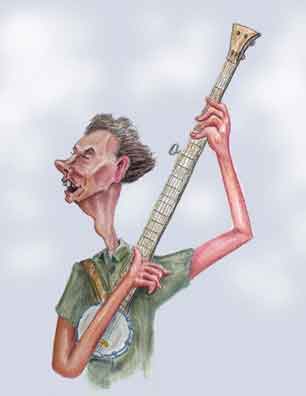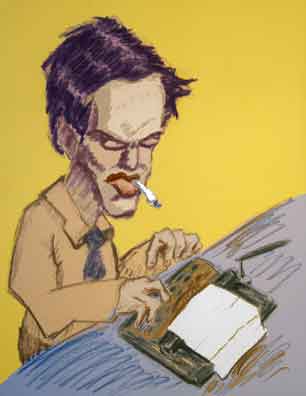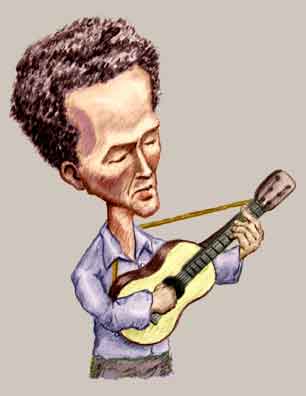Pete Seeger
America's Balladeer

Pete Seeger
American Patriot
Pete Seeger was born on May 3, 1919 into a musical family, the third of three children. His mom, Constance de Clyver, was a violinist and his dad, Charles, a distinguished musicologist who taught at Berkeley, Julliard (where Constance was a student and later a teacher), and then at UCLA. The marriage of Charles and Constance lasted for fifteen years, and Charles later married Ruth Crawford who was a composer who had studied composition in Europe. Charles and Ruth had two children, Mike and Peggy, who both became famous folks singers in their own right.
Pete enrolled at Harvard in 1936 but dropped out after two years saying he got too involved in politics, which at the time was the cool thing for college students to do. He then went to work as a volunteer at the Library of Congress Archive of American Folks Song where his boss was Alan Lomax .
Alan, himself the son of folk music collector John A. Lomax, encouraged Pete to take up the banjo ("He just looked like a banjo", Alan said) and so Pete bought an instrument. Then with a list of banjo players from the Archives files, he hitchhiked around the south, learning from the folk masters themselves. When he returned at the end of the summer, he was actually pretty good. Pete then settled in New York City. At that time Manhattan was a surprisingly cheap place to live. The subway only cost a nickel and if you wanted a break from the hustle and bustle of the city, you could take a train up to the scenic Hudson Valley.

Pete Seeger
Pete's Boss and the LOC
Pete moved into a loft apartment which housed a rather ill-defined and changeable group of people, but all of whom shared a love of folk music. Most of his roommates were in his own age group, but some - such as Woody Guthrie and Lee Hays - were a few years older. They formed what later became the first of the urban folk groups - the Almanac Singers - and began playing around town. Sometimes they even got paid.
This was the time of Roosevelt's New Deal which may have helped some to move the country out of the Great Depression. But not much, and there were a lot of people who pointed to the "Great Experiment" of the then young Soviet Union to unite the workers of the world. The American Communist Party (officially styled Communist Party - USA) had a membership of perhaps 20,000 in the early 1930's. Although not very successful in getting many candidates elected, the CPUSA was one of the strongest supporters of the union movement.
Some of the Almanac singers were, if not actual members, supporters of the party platform (whatever it was) or at least sympathetic to the ideas of having a centralized control economy with workers in charge of the businesses. Woody, although probably not an actual member, always considered himself a philosophical communist and his "Woody Sez" column appeared in the party newspaper the Daily Worker. Pete himself had joined the Young Communists League in 1937 and the party in 1940, only to sever his ties when it became evident the actual implementation was not matching the idealism.
World War II broke the group up. Pete like many able bodied young men was drafted and he ended up stationed in the South Pacific. Woody ended up in the Merchant Marines with his friends Jimmy Longhi and singer Cisco Houston (whose version of The Cat Came Back later became a standard) where the three shipmates had the infamous "Battle of the Beans". But after the War, the singers got back together and in 1948 campaigned for Progressive Party candidate Henry Wallace for President. This was still a time when Left was Left and Right was Right and ne'er the twains would meet. The Wallace Campaign expected Henry, if not to win, then put up a respectable showing. Unfortunately, many Americans saw the Progressive Party as a thin veneer for the CP-USA, and the growing fear of Communist expansion and dictatorship (a fear that was not alleviated by the actions of communist leaders like Josef Stalin) pretty much squelched any possibility that Henry would get any votes other than the campaign workers. Henry lost by a landslide, the folk music scene in New York evaporated, and Pete began to wonder if he shouldn't just get a job in a factory.
But Pete and former Almanac singer Lee Hays, along with singer Ronnie Gilbert and singer and guitarist Fred Hellerman, formed a group they called the Weavers. They began appearing at a New York night club, the Village Vangaurd although the owner, a friend of Pete's, had been a bit skeptical that a folk group would "make it" in the Big Apple. But soon the Weavers were filling the house. They began releasing recordings which did very well, appeared in short movie clips, and became a hot item in American entertainment. The Weavers sang and played with a professional polish not always present in the Almanac Singers, and Pete's by now virtuoso banjo playing was a strong contributor to the group's success. In 1950, they released a recording of Leadbelly's "Irene" (horribly sanitized by and having equal billing on the label with the orchestra of Gorden Jenkins). It became the #1 Hit of the Year.

Woody Guthrie
A few years older
But it was also in 1950 that a senator from Wisconsin named Joe McCarthy began trying to ferret out communists in the US government. His definition of a communist was anyone who he didn't like, and his methods were so extreme that Joe ended up begin censured by a conservative Senate controlled by his own party. In recent years there have been the inevitable attempts to rehabilitate Joseph's image as an unfortunate victim of Enemies of the Real America, but the attempts have not been particularly successful.
The Red Scare put an end to the Weavers. Because of their past politics, Pete, Fred, Lee, and Ronnie found themselves unable to get any bookings and the group split up. Pete and Lee were called before the House of Un-American Activities Committee (HUAC) - itself one of the most un-American activities that America decided to undertake. Pete was asked questions about his personal politics - such as if he was a communist - which he declined to answer based on constitutional grounds. No, Pete did not plead the Fifth Amendment. He plead the First Amendment which he felt gave him the right to keep his personal opinions and politics to himself. He was then cited for contempt of Congress, a charge that was later overturned on technical grounds.
Of course, Pete was not the only artist to find himself on the infamous blacklist. Lee, too, found himself on the list (later he said that if it wasn't for the honor of the thing, he would have preferred not to be blacklisted). Unable to get any other kind of work, Pete began touring the college circuit and performing abroad. Even well into the 1960's when the folk music revival made folk music a paying proposition, Pete was effectively banned from mainstream television shows like Hootenanny. Some performers in a show of solidarity with Pete refused to appear, although Pete - as was typical - encouraged them to go on the show.
But things began to thaw and in 1966, Pete was able to produce and star in a folk music show for television, Rainbow Quest. Sadly the show had very limited airing, although in the early 1990's some shows appeared in video cassettes and later on DVD's. A Personal CooperToons Opinion is that these shows are folk music at its best. The guests were a literal who's who of folk and country music - Doc Watson with Fred Price and Clint Howard, Johnny Cash and his soon-to-be-wife June Carter, Mississippi John Hurt, Tom Paxton, the Stanley Brothers, Hedy West, Tommy Makem and the Clancy Brothers, Malvina Reynolds, Jean Ritchie, New Lost City Ramblers (with Pete's brother Mike), actor and singer Theodore Bikel (who actually had auditioned for the role of Goldfinger in the James Bond film), Judy Collins, and Native American singer Buffy St. Marie. Pete also had some shows where he would talk about and play songs about topics like the history of political satire or sing songs by people he knew like Leadbelly (who had died in 1949 of Lou Gehrig's disease) and Woody Guthrie. Although Woody was still alive at the time of the broadcast, he was permanently confined to a hospital, and within a year had died of Huntington's disease.
Fortunately, even during the worst days of the blacklist, Pete was able to keep making records largely due to the efforts of Moses Asch, the owner, engineer, administrator, and everything else of Folkways Records. Moe, whose father was the Jewish writer Sholem Asch, had loved folk music since he picked up a copy of John Lomax's Cowboy Songs in (of all places) a bookstall on the Seine in Paris. He had studied electronics in Germany and when he came to America in the 1930's, he founded the Asch Records Company. In 1948, he changed the name to Folkways Records, and Moe's policy was that he issued records for their education value, not because they would make money. Best of all once he recorded an album, it would never go out of print. If the company was never a big money maker for Moe, it was, as they say, a living.
In our digital age it's easily forgotten what a complex process recording was. At the Folkways studios, the performers would get inside the recording booth - scarcely the size of a large closet - and Moe would sit in the control room which was a bit larger. Moe would give the signal, and the performers would play. The early recordings were made "directly", that is cut onto a disc "master" rather than tape (which wasn't widely available). If you made a mistake you had to start over again or - as was usually the case - you just put out the album, mistakes and all. Fortunately, Pete's playing was - although he would have probably denied it - largely error free and are among Moe's best products.
Folkways bookkeeping, though, was a bit haphazard, and although Moe would usually pay the artists a flat fee at the session and take them to lunch, he was never noted for prompt payment of royalties. Pete, though, figured that Moe was recording and issuing folk recordings that the big name labels wouldn't bother with. "Heck, I wasn't going to bother about royalties," Pete said. But the singer and guitarist Dave Van Ronk would sometimes dress up in a ragged suit and wait until the Folkway's office was filled with people waiting to see Moe. Then he'd stagger in as if on his last legs and cry out, "Moe! You're not paying me!" Moe would play the game and say, "Dave! I'm glad your here. I was just about to write you a check." Then he'd write a check for $50 and hand it over.
Pete's attitude toward royalties for his Folkway's records was typical. The Vega banjo company asked Pete if they could produce a model of the Pete's long necked banjo. Pete had cut the neck of a regular banjo and added two extra frets to facilitate playing in different keys (five string banjos normally have five frets above the fifth string key). They asked if they could call it the "Pete Seeger Model". Pete said he would be honored, but declined the offer to be paid a royalty. Later, though, a company official called Pete and asked if they could send him one of their banjos. Pete said he'd be delighted although he felt he may have been corrupted a bit by receiving such a high quality instrument as a gift.
However, don't worry that Pete didn't get richly deserved royalties on some his songs; in other cases, he did. He and Lee wrote If I Had a Hammer on a concert tour in the 1940's and Pete and the Weavers recorded it on what he said was a "collector's item". The collectors, Pete said, were about the only ones who had bought the record. But then in the early 1960's, the popular group of Peter Yarrow, Paul Stookey, and Mary Travers - ergo, Peter, Paul, and Mary for those who have to have it spelled out - recorded the song on their first album and it became a pop hit. Since then it has been recorded by some of the biggest singers of the 20th century.
Probably the most widely disseminated of Pete's song was Turn! Turn! Turn! whose lyrics were drawn from Ecclesiastes. After the song was released by the group The Byrds it rose to the #1 spot in 1965. Others of Pete's songs also became popular, so popular that people who sang them didn't realize Pete wrote them. The Kingston Trio issued the song Where Have All the Flowers Gone?, and knowing no better, they simply labeled it as "trad." But then they got a note pointing out that Pete was both the composer of the song and the owner of the copyright. The group was surprised, begged Pete's pardon, and corrected the attribution on the next release.
By the late 1960's, Pete was again appearing on mainstream television, and major recording companies were issuing his albums (the Essential Pete Seeger by Vanguard is hard to beat). He often played concerts with Woody's son, Arlo, and he made the rounds of day-time talk shows, appeared on the Tonight Show, and even appeared as a guest on the Johnny Cash Show. Johnny himself had appeared, as we said, with his soon-to-be wife, June Carter, on Pete's Rainbow Quest.
But Pete's appearances were not always without controversy. On the Smothers Brothers Comedy Hour, Pete sang Waist Deep in the Big Muddy, an anti-Vietnam War song, and Pete later watched the broadcast (which as most TV shows by then was taped). He had finished playing a song accompanied on the twelve string guitar (which he also used for Big Muddy). The camera cut to Tommy who asked if Pete was going to play that song, and the camera cut back to show Pete holding a banjo. Yes, the song had been cut out. Tommy and his brother Dick were as miffed as Pete about the editing. They later announced Pete would be back and would sing the song. Which he did.
In the later 1960's Pete became active in environmental issues, particularly along the Hudson River. That was the time when the prevailing philosophy was that voiced by the chemical engineering student who once said you didn't need to worry about pollution killing fish because they'll just swim out of the pollution, won't they? But for whatever reason, whether the fish had been killed or just swam away, the Hudson had been so choked with industrial pollution that there was quite literally nothing that could live in the water. Pete and a group of performers set sail on the sloop Clearwater and performed up and down the river. Pete's and the others' publicity must have had some effect, and more stringent emissions and effluent standards followed. Today waste from many manufacturing facilities are in the pounds per days rather than in the tons, and later in the 1970's Pete mentioned on the Tonight Show that the fish had returned to the Hudson River.
As the Millennium rolled over, Pete had been singing for over six decades. He played everywhere from high school gymnasiums to Carnegie Hall and you get the impression he actually enjoyed playing in the former as much if not more than the latter. He would, he said, sing for anyone. "I'll sing for the John Birch Society if they ask me," Pete quipped, adding "They've never asked me."
Pete married Toshi Aline-Ota, a Japanese American, in 1943. Toshi, who worked largely behind the scenes, acting as Pete's manager, financial officer, and producer of many projects. Of course, as his manager, Toshi lived with Pete's problems as much as - you can say more than - he did himself. After Pete's citation for contempt of Congress, Toshi figured that the majority of the bookings for that year would be canceled so she accepted every offer that came in. However, nothing was canceled, and Pete never went to jail. Of course, with so many concerts, it was a nightmare for Toshi to keep everything organized.
"Never again," she said. "Next time let him go to jail."
In 1949, Pete and Toshi moved to Beacon, New York, living - literally - in a cabin they built themselves. Sadly Toshi died on July 9, 2013, age 91 and Pete himself followed her six months later on January 27, 2014 - at a youthful 94.
References
The Incompleat Folksinger, Pete Seeger, Simon and Schuster, 1972. Pete's autobiography.
How Can I Keep from Singing?, David Duncan, McGraw-Hill, 1981. Pete's biography. Lot's of interesting stuff about Pete's early years.
Interview with Pete Seeger, Tim Robbins (Pacifica Radio), 2006. Pete talks about the early days with the Almanac Singers.
"Toshi Seeger, Wife of Folk-Singing Legend, Dies at 91", Douglas Martin, the New York Times, July 11, 2013.
Woody Guthrie: A Life, Joe Klein, Knopf, 1980. Woody's first real biography with a lot about Pete, who was a major source for the book.
Two very good websites about Pete are:
Pete Seeger Appreciation Page, http://peteseeger.net/wp/
Pete Seeger Music Page, Appleseed Records, http://peteseeger.net/wp/
Interview: Toshi-Aline Ota Seeger, http://www.persimmontree.org/v2/summer-2012/toshi-aline-ota-seeger/
"Pete Seeger, Songwriter and Champion of Folk Music, Dies at 94", Jon Parlesjan, New York Times, January, 28, 2014